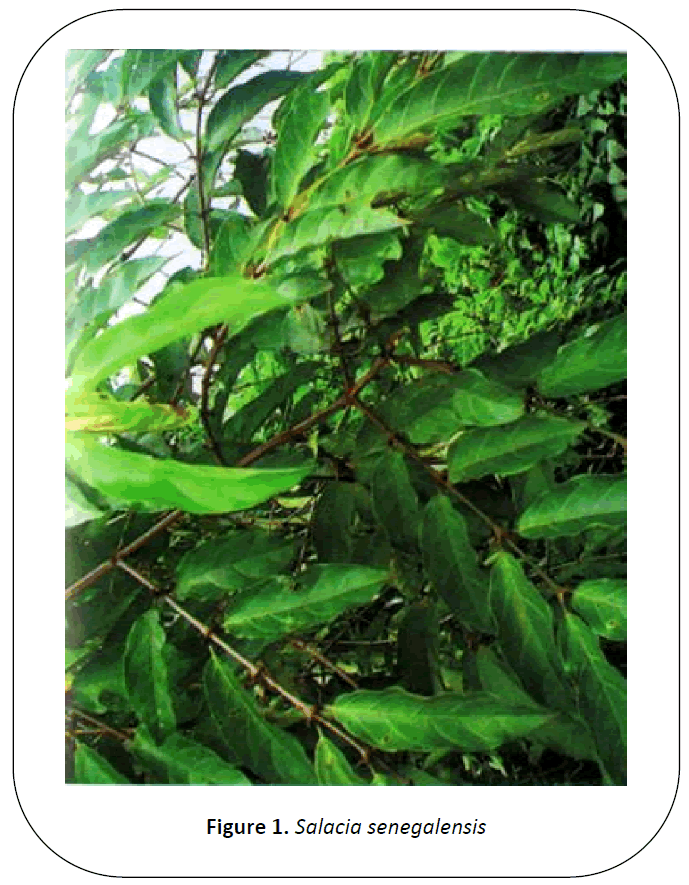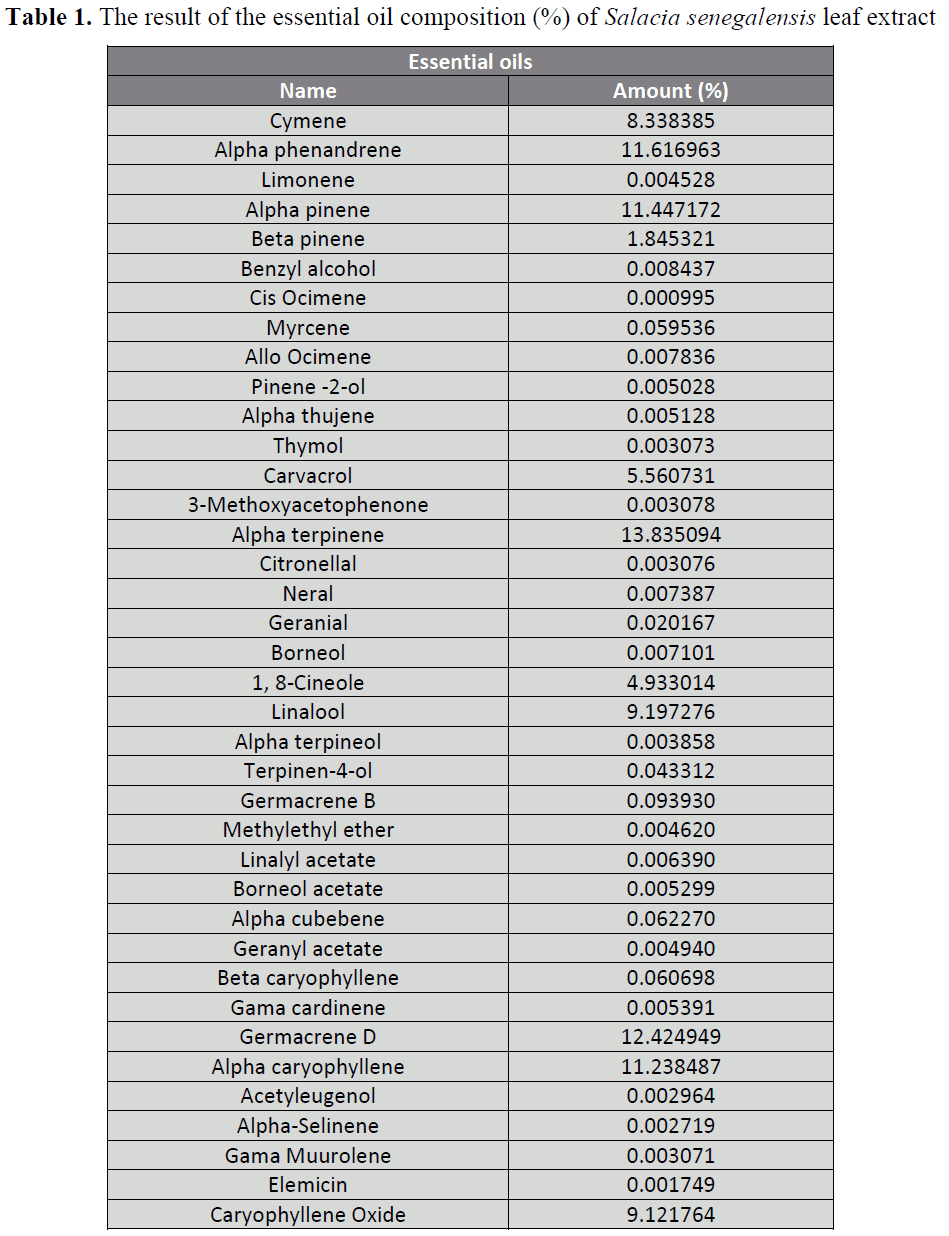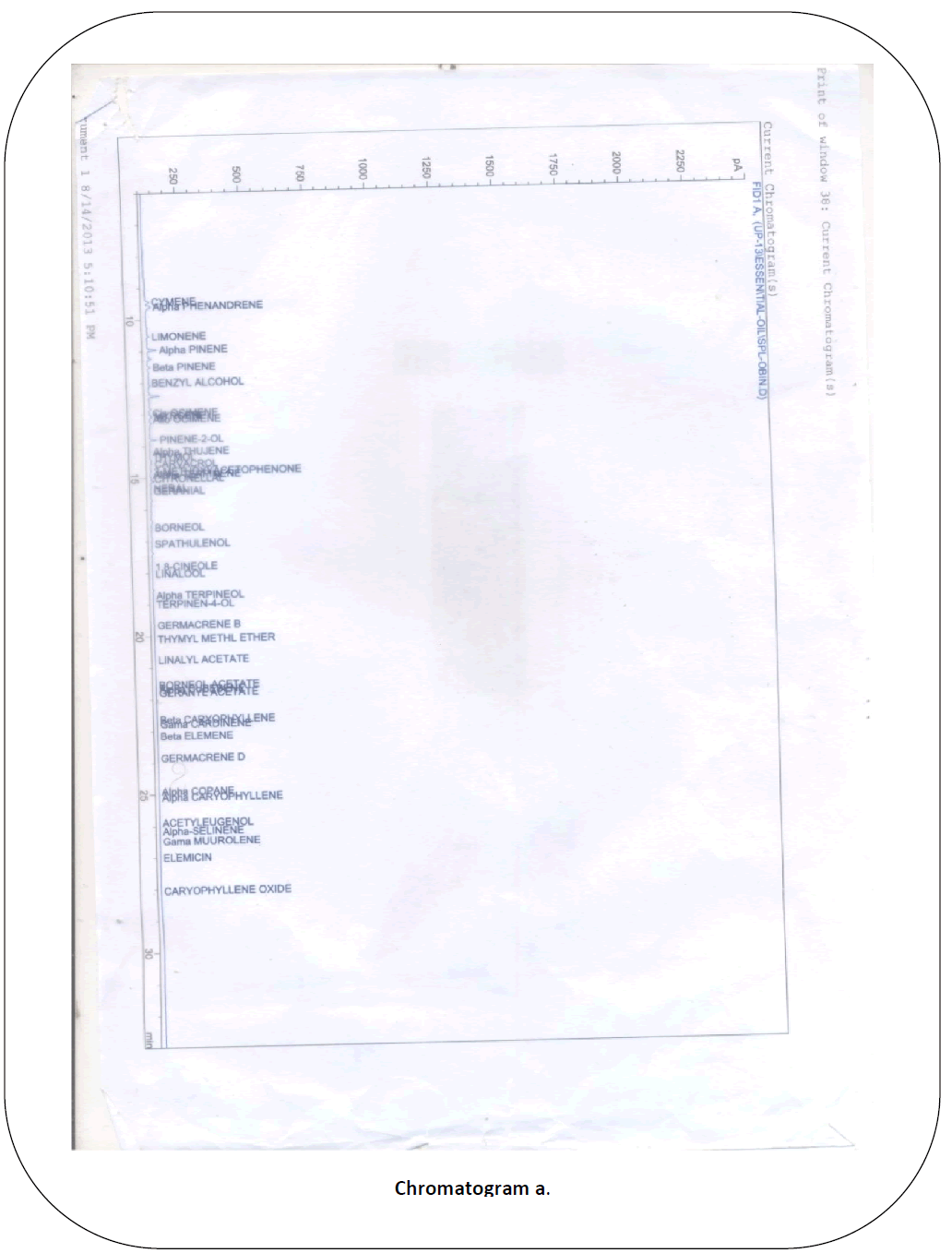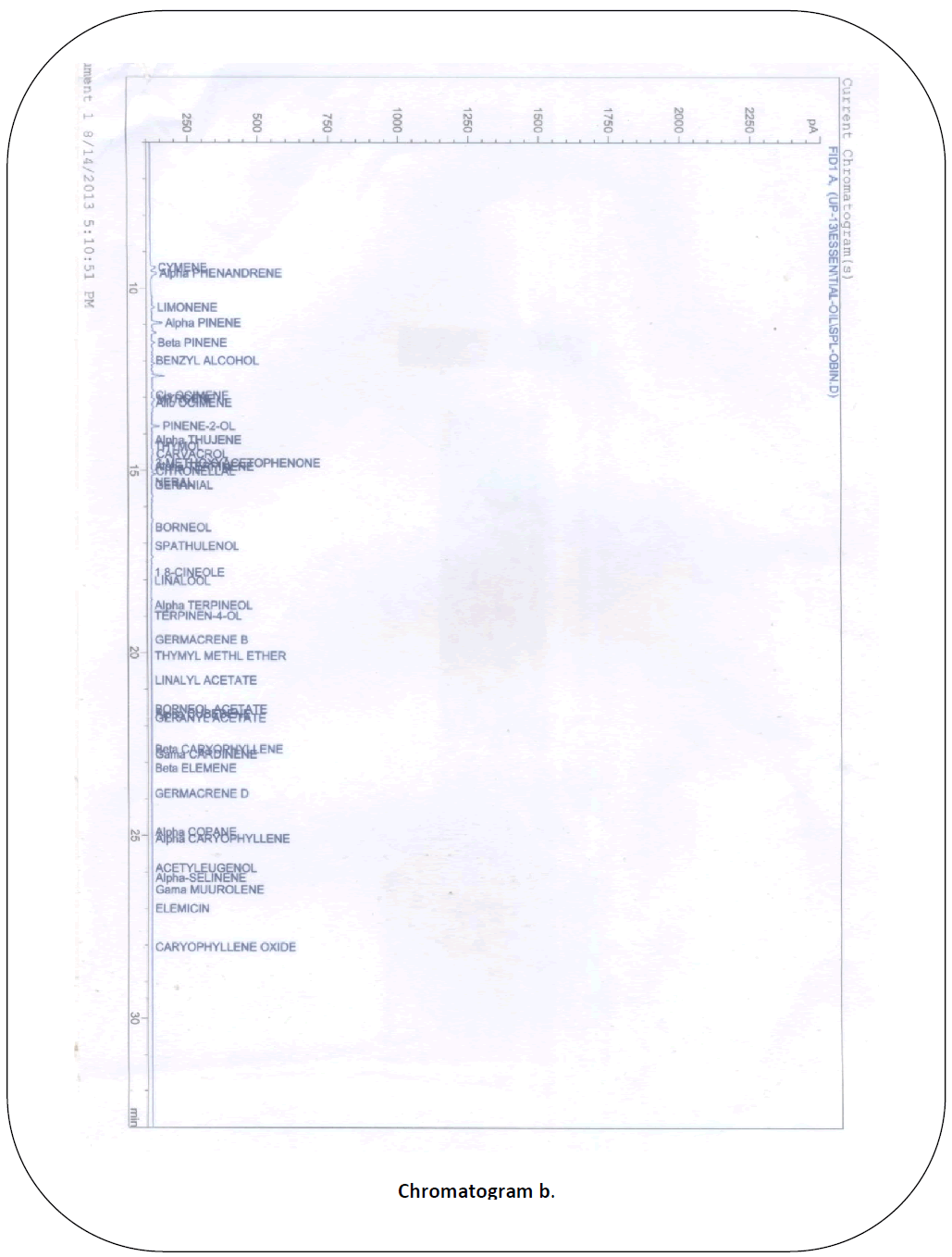Keywords
Essential oil, Medicinal, Salacia senegalensis, GC
Introduction
Salacia senegalensis Lam (DC) is a
shrub erect or climbing with white or pale
greenish cream petals and orange or yellow
flowers. It belongs to the family
Celestraceae [1]. Traditionally, the leaf extracts
are used as antimalarials, lotion for sick
children and in the treatment of skin
problem like eczema by the people of the
South-East zone of Nigeria [1]. Since ancient
times, essential oils have been recognized
for their medicinal value and they are very interesting and powerful natural plant
products. They continue to be of paramount
importance until the present day. Essential
oils have been used as perfumes, flavors for
foods and beverages, or to heal both body
and mind for thousands of years [2-5]. In the
era of the Renaissance, Europeans have
taken over the task and with the
development of science the composition and
the nature of essential oils have been well
established and studied [6-9].
Essential oils (also called volatile or
ethereal oils, because they evaporate when
exposed to heat in contrast to fixed oils) are
odorous and volatile compounds found only
in 10% of the plant kingdom and are stored
in plants in special brittle secretory
structures, such as glands, secretory hairs,
secretory ducts, secretory cavities or resin
ducts [10-17]. Essential oils constitute a major
group of agro-based industrial products and
they find applications in various types of
industries, such as food products, drinks,
perfumes, pharmaceuticals and cosmetics [6,18-24]. Germacrene D, α-Caryophyllene and α-
Pinene are cytotoxic to cancer cells [25]. Anticarcinogenic
property of Linalool has been
reported [26]. Also, anti-bacterial properties of
Carvacrol, α-Terpinene and Cymene have
been reported [27]. However, no scientific data
on essential oil (terpenes) composition of the
Salacia senegalensis leaf has been reported;
therefore, the aim of this work is to analyze
the essential oil compositions its leaf.
Materials and Methods
Plant material collection and
authentication
The acclaimed medicinal plant Salacia senegalensis (figure 1) was obtained
from the forest of Orji Owerri North L.G.A,
Imo State, Nigeria, identified and
authenticated by taxonomists Prof Okeke, SE
and Mbagwu, FN (PhD) of the Department of
Plant Science and Biotechnology Imo State
University, Owerri, Nigeria.
Figure 1: Salacia senegalensis
Extraction and isolation of essential oil
The extraction was carried out
according to the method of [28].
Principle
The leaf was extracted with
chloroform, before subjecting the extract to
chromatographic analysis.
Materials
These include,
1. The leaf sample (whole leaf powder)
2. Re-distilled chloroform
3. Weighing balance, water bath, rotary
evaporator, timer, GC machine, 250ml
conical flask, 100ml borosilicate beakers,
Whatman N0.1 filter paper and funnel.
Procedure
Three grams of the pulverized sample
were extracted three times with 30ml of redistilled
chloroform for 15 minutes at a
regulated temperature of 40°C in a 250 ml
conical flask, placed in a water bath. The
resultant mixture was filtered with Whatman
N0.1 Filter paper and the filtrate concentrated
to 1ml in the vial for gas chromatography
analysis and 1μL was injected into the
injection port of the GC.
Chromatographic conditions
The gas chromatograph was an HP
6890 (Hewlett Packard, Wilmington, DE,
USA), GC apparatus, fitted with flame
ionization detector (FID), powered with HP
Chemstation Rev. A09.01 [1206] software, to
identify compounds. The column was a
capillary HP 5MS column (30 m x 0.25 mm x
0.25 μm film thickness). The inlet and
detection, temperature were 150 and 300°C.
Split injection was adopted with a split ration
of 20:1. Hydrogen was used as the carrier gas,
at a flow rate of 1.0ml/min. The hydrogen and
compressed air pressure were 22psi and
28psi. The oven was programmed as follows:
initial temperature of 40°C. Ramped at 5°C/min to 200°C, and ran at 200°C for 2
minutes.
Results and Discussion
The leaves of this plant Salacia
senegalensis are rich in essential oil as shown
in Table 1. The Table 1.0 showed the amount
in percentage of these oils. A total of 38
compounds was identified and quantified. The most abundant are α-Terpinene (13.8 %),
Germacrene D (12.4%), α-Phenanthrene
(11.6%), α-Pinene (11.5 %), α-Caryophyllene
(11.2 %), Linalool (9.2 %), Caryophyllene
Oxide (9.1 %), Cymene (8.3 %), Carvacrol
(5.6 %), 1, 8-Cineole (4.9 %) and β-Pinene
(1.8 %). Germacrene D, α-Caryophyllene
and α-Pinene found in the leaf of this plant
are cytotoxic to cancer cells [25]. Linalool found
in this leaf is anti-carcinogenic [26]. Also, antibacterial
properties of Carvacrol,
Caryophyllene Oxide, and α-Terpinene and
Cymene found in the leaf of this plant has
been reported [27]. Essential oils have many
uses, both in pharmacology and in food.
Essential oils exhibit antimicrobial activities,
antiviral activities with broad spectrum, and
may be useful as natural remedies and it
seems that essential oils can be used as a
suitable therapy for many pathologies [2-5]. In
the cosmetic and in the food industry,
essential oils are useful and may play
different roles. (See Chromatogram a & b).
Table 1: The result of the essential oil composition (%) of Salacia senegalensis leaf extract
Conclusion
The leaves of this plant Salacia
senegalensis are rich in essential oil,
especially Alpha Terpinene, Germacrene D,
Alpha Pinene, Alpha Caryophyllene,
Linalool, Cymene, and Carvacrol, which has
medicinal properties as discussed, thereby
suggesting/ supporting the medicinal property
of the leaf of this plant as used by the people
of the South-East zone of Nigeria.
Conflict of interest
None.
References
- Nigeria National Medicine Development Agency (NNMDA) (2011) Salacia senegalensis, Medicinal plants of South- East Zone. Vol.1 pp 67.
- Baris, O.; Güllüce, M.; Sahin, F.; Ozer, H.; Kılıc, H.; Ozkan, H.; Sökmen, M. and Ozbek, T. (2006). Biological activities of the essential oil and methanol extract of Achillea biebersteinii Afan Afan (Asteraceae). Turkish J. Biol., Vol.30, pp.65-73.
- Margaris, N.; Koedam A. and Vokou, D. (1982). Aromatic Plants: basic and applied aspects. The Hague, London, Boston, Martinus Nijhoff Publishers.
- Tisserand, R. B. (1997). In The Art of Aromatherapy; Healing Arts Press: Rochester, VT.
- Wei, A. and Shibamoto, T. (2010). Antioxidant/Lipoxygenase Inhibitory Activities and Chemical Compositions of Selected Essential Oil. J. Agric. Food Chem. Vol.58, pp. 7218-7225.
- Burt, S. (2004). Essential oils: their antibacterial properties and potential applications in foods. International Journal of Food Microbiology, Vol.94, pp. 223-253.
- Peeyush, K.; Sapna, M.; Anushree, M.and Santosh, S. (2011). Insecticidal properties of Mentha species. Industrial Crops and Products, Vol.34, pp. 802- 817.
- Steven, B.K. (2010). Traditional Medicine: A global perspective. Edited by Steven B. K.; Pharmaceutical Press.
- Suaib, L.; Dwivedi, G.R.; Darokar, M.P.; Kaira, A. and Khanuja, S.P.S. (2007). Potential of rosemary oil to be used in drug-resistant infection. Alternative therapies, Vol.13, pp. 54-59.
- Ahmadi, L.; Mirza, M. and Shahmir, F. (2002). The volatile constituents of Artemisia marschaliana Sprengel and its secretory elements. Flavour Fragr. J., Vol.17, pp. 141-143.
- Bezić, N.; Šamanić, I.; Dunkić, V.; Besendorfer, V. and Puizina, J. (2009). Essential Oil Composition and Internal Transcribed Spacer (ITS) Sequence Variability of Four South-Croatian Satureja Species (Lamiaceae). Molecules, Vol.14, pp. 925-938.
- Ciccarelli, D.; Garbari, F. and Pagni, A.M. (2008). The flower of Myrtus communis (Myrtaceae): Secretory structures, unicellular papillae, and their ecological role. Flora, Vol.203, pp. 85- 93.
- Gershenzon, J. (1994). Metabolic costs of terpenoid accumulation in higher plants. Journal of Chemical Ecology, Vol. 20, pp. 1281-1328.
- Liolios, C.C.; Graikou, K.; Skaltsa, E. and Chinou, I. (2010). Dittany of Crete: A botanical and ethnopharmacological. Journal of Ethnopharmacology, Vol. 131, pp. 229-241.
- Morone-Fortunato, I.; Montemurro, C.; Ruta, C.; Perrini, R.; Sabetta, W.; Blanco, A.; Lorusso, E. and Avato, P. (2010). Essential oils, genetic relationships and in vitro establishment of Helichrysumitalicum (Roth) G. Don ssp. italicum from wild Mediterranean germplasm. Industrial Crops and Products, Vol. 32, pp. 639-649.
- Sangwan, N.S.; Farooqi, A.H.A.; Shabih, F.; and Sangwan, R.S. (2001). Regulation of essential oil production in plants. Plant Growth Regulation, Vol.34, pp.3-21.
- Wagner, G.J. (1996). Secreting glandular trichomes: More than just hairs. Plant Physiol. Vol.96, pp. 675-679.
- Anwar, F.; Ali, M.; Hussain, A.I.; and Shahid, M. (2009a). Antioxidant and antimicrobial activities of essential oils and extracts of fennel (Foeniculum vulgare Mill.) seeds from Pakistan. Flavour Fragr. J., Vol.24, pp.170-176.
- Anwar, F.; Hussain, A.I.; Sherazi, S.T.H. and Bhanger, M.I. (2009b). Changes in composition and antioxidant and antimicrobial activities of essential oil of fennel (Foeniculum vulgare Mill.) fruit at different stages of maturity. Journal of Herbs, Spices and Medicinals Plants, Vol. 15, pp.1 16.
- Celiktas, O. Y.; Kocabas, E. E. H.; Bedir, E.; Sukan, F. V.; Ozek, T. and Baser, K.H.C. (2007). Antimicrobial activities of methanol extracts and essential oils of Rosmarinus officinalis, depending on location and seasonal variations. Food Chemistry, Vol. 100, pp. 553-559.
- Hammer, K.A.; Carson, C.F.; Dunstan, J.A.; Hale, J.; Lehmann, H.; Robinson, C.J.; Prescott, S.L. and Riley, T.V. (2008). Antimicrobial and antiinflammatory activity of five Taxandriafragrans oils in vitro. Microbiology and immunology, Vol.52, pp. 522-530.
- Hay, R.K.M. and Svoboda, K.P. (1993). Botany. In Volatile oil crops: their biology, biochemistry and production, Hay, R.K.M. and Waterman, P.G. (eds.), Longman Scientific & Technical, Harlow, pp. 5-22.
- Hussain, A.I.; Anwar, F.; Sherazi, S.T.H.; and Przybylski, R. (2008). Chemical composition, antioxidant and antimicrobial activities of basil (Ocimumbasilicum) essential oils depends on seasonal variations. Food Chem., Vol. 108, pp. 986-995.
- Teixeira da Silva, J.A. (2004). Mining the essential oils of the Anthemideae. African Journal of Biotechnology, Vol.3, pp. 706-720.
- Palazzo, M.C, Wright, H.L, Agius, B.R, Wright B.S, Moriarity D.M, Haber, W.A and Setzer, W.N(2009) Chemical compositions and biological activities of leaf essential oils of six species of Annonaceae from Monterer de, Costa Rica. Records of natural products 3:3 pp153-160.
- Burt, S.A, Vlielander, R, Haagsman, H.P, Veldhuize, E.J.A(2005) Increase in activity of essential oil components Carvacrol and Thymol against Escherichia coli 0157:H7 by addition of food stabilizers. Journal of food protection, vol 8 no. 5 pp 919-926.
- Srithar, G., Sudha, M and Nalini N (2013) Linalool exerts dose dependent chemopreventive effect against 1, 2- dimethylhydrazine induced rat colon carcinogensis. Int’l Journal of pharmaceutical and biological archives. 4(4): 758-770.
- Ortan, A, Popescu, ML, Gaita, AL, Dinu-Pîrvu, C and Câmpeanu, GH (2009) Contributions to the pharmacognostical study on Anethum graveolens, Dill (Apiaceae). Romanian Biotechnology Letters. 14(2): 4342- 4348.





